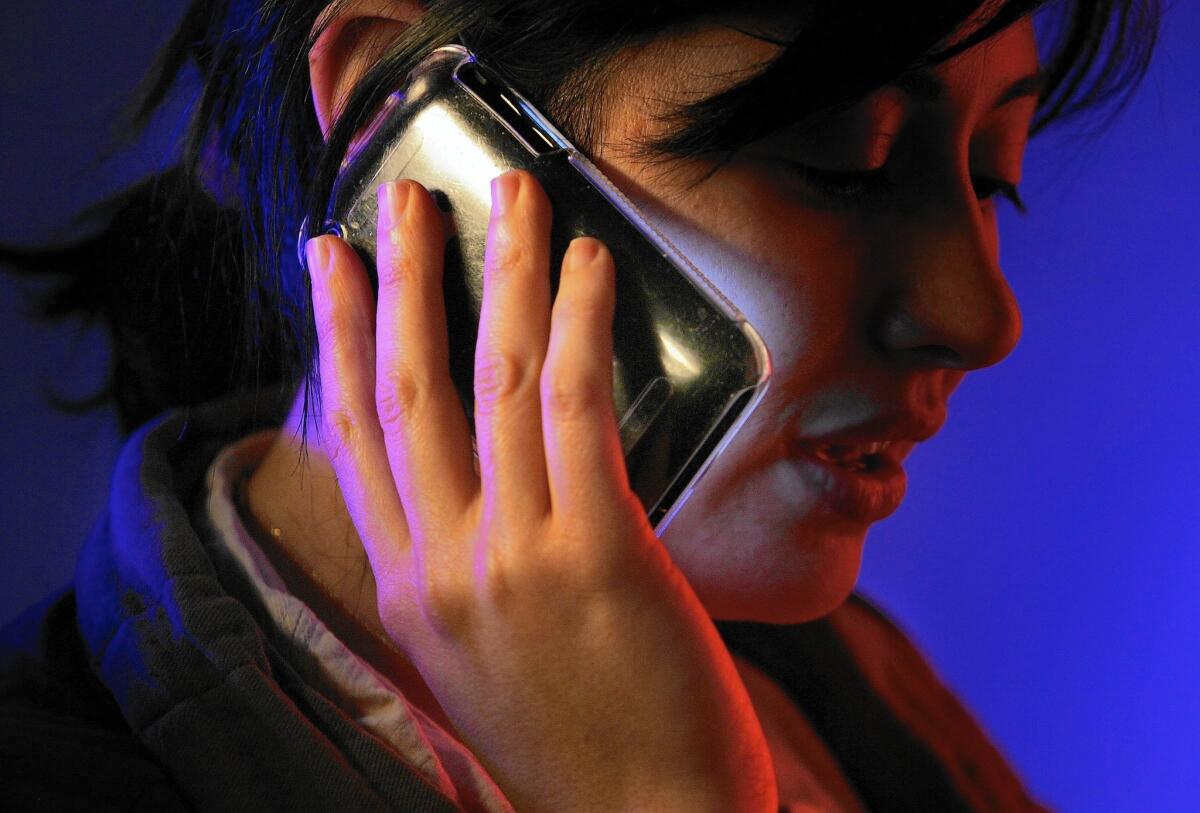Berkeley’s warning about cellphone radiation may go too far

Considering that 90% of U.S. adults own a cellphone, according to the Pew Research Center, the question of possible health dangers isn’t a trivial one.
It’s a question that just won’t go away: Do cellphones give you cancer?
The city of Berkeley has passed an ordinance that, beginning next month, would make it the first municipality in the country to require that cellphone retailers warn customers that mobile devices may emit cancer-causing radiation.
The wireless industry’s trade group responded last week with a federal lawsuit claiming that its 1st Amendment rights were being violated by being forced to disseminate an opinion that it says is false.
CTIA — the Wireless Assn. said in its complaint that Berkeley’s warning is “misleading, controversial and government-crafted” and will “stoke fear in consumers about the dangers of cellphones.”
Here’s the thing: Both sides are right.
Berkeley officials are correct in saying that radiation from cellphones may pose a risk of cancer to the brain and other organs because of their proximity to the body.
No less an authority than the World Health Organization has concluded that “the electromagnetic fields produced by mobile phones are … possibly carcinogenic to humans.”
But WHO, like almost every other scientific body that’s studied the question, acknowledges that nothing is known for sure.
As the Mayo Clinic puts it: “For now, no one knows if cellphones are capable of causing cancer. Although long-term studies are ongoing, to date there’s no convincing evidence that cellphone use increases the risk of cancer.”
Considering that 90% of U.S. adults own a cellphone, according to the Pew Research Center, the question of possible health dangers isn’t a trivial one.
But I think the wireless industry’s position in this case is stronger than Berkeley’s.
Lots of things may harm you. Do we really want to go through life being constantly bombarded by warnings of possible danger, especially when there’s no definitive science on the matter?
Cigarettes can kill you. There’s no disputing that fact. It seems perfectly reasonable that cigarette packages include health warnings.
But should every container of French fries include a warning that they could lead to heart disease or diabetes? Should sneakers include a warning that going for long runs could damage your knees and hips?
David Stewart, a professor of marketing at Loyola Marymount University who specializes in warning labels, said moderation is needed when it comes to informing the public about health hazards.
“If everything is dangerous, then nothing is dangerous,” he said. “There has to be evidence that a danger is real.”
Stewart said his research has shown that the more warnings consumers encounter, the less effective each warning becomes in communicating a risk. At some point, he said, people just start ignoring them.
“Do we really want to discourage people from using their cellphones?” Stewart said. “We do when they’re driving, but what do we hope to accomplish by warning about a speculative risk?”
Dr. Joel Moskowitz, a researcher at UC Berkeley’s School of Public Health who has studied cellphone radiation, countered that the cancer risk of wireless devices is more than speculative.
“I’d say it’s a probable risk,” he said, though he acknowledged that studies have yet to produce irrefutable evidence that cellphones cause cancer. Moskowitz has served as a scientific advisor to Berkeley officials.
Radiation tests conducted by the Federal Communications Commission use liquid-filled dummies “to simulate the way different users’ typically hold a cellphone, including to each side of the head.” The FCC sets emission standards based on these tests.
The Berkeley City Council voted unanimously in May to require that cellphone retailers post signs and hand out notices stating that “the federal government requires that cellphones meet radio frequency exposure guidelines.”
“If you carry or use your phone in a pants or shirt pocket or tucked into a bra when the phone is on and connected to a wireless network, you may exceed the federal guidelines for exposure to RF radiation,” it says.
“This potential risk is greater for children. Refer to the instructions in your phone or user manual for information about how to use your phone safely.”
While that might sound like straightforward, common-sense advice, the wireless industry says it goes too far.
CTIA declined to discuss the matter with me. But it offered a statement from its high-profile lawyer for the case, Ted Olson.
“Berkeley’s ordinance plainly violates the 1st Amendment,” he said. “It is unconstitutional to force cellphone retailers to communicate false, misleading and inflammatory information about their products.”
San Francisco tried a similar warning in 2010 about the potential danger of cellphones. But the city’s Board of Supervisors dropped the idea after the wireless industry mounted a legal challenge almost identical to its attack on the Berkeley ordinance.
Moskowitz said Berkeley officials learned from San Francisco’s experience. Berkeley’s warning has been worded carefully to address legal concerns, he said.
A key difference: San Francisco’s statute said cellphone radiation poses a cancer risk. Berkeley’s says that radiation exposure from carrying a cellphone may exceed federal guidelines. It makes no reference to cancer.
Caroline Mala Corbin, a law professor at the University of Miami specializing in 1st Amendment issues, said there are two elements to disclosure cases.
First, is the required disclosure factual? That is, does available evidence support the information being conveyed?
Second, does the warning reflect an ideological bias? If so, Corbin said, it could be deemed unconstitutional because it compels people to say questionable things they might disagree with.
She cited a North Carolina law that required doctors to perform an ultrasound on any woman seeking an abortion, display the sonogram on a screen and describe the fetus to the woman. The law said doctors must display and describe the image even if the woman averted her eyes or tried not to listen.
The U.S. Supreme Court this month let stand a lower court ruling that such compelled speech clearly reflected lawmakers’ ideological beliefs and, therefore, violated doctors’ 1st Amendment rights.
In the Berkeley case, Corbin said: “If the court thinks this is factual information that’s helpful to consumers, it could be fine. But if it thinks the city is expressing an ideological opinion, it could rule against the ordinance.”
I respect Berkeley’s desire to safeguard consumers from potential harm. I, too, have wondered if having a radiation-emitting device on my body all day long is a good idea.
But until the scientific community can address the cancer risk of cellphones more decisively, it seems the city may be overreaching.
For now.
David Lazarus’ column runs Tuesdays and Fridays. He also can be seen daily on KTLA-TV Channel 5 and followed on Twitter @Davidlaz. Send your tips or feedback to david.lazarus@latimes.com.







